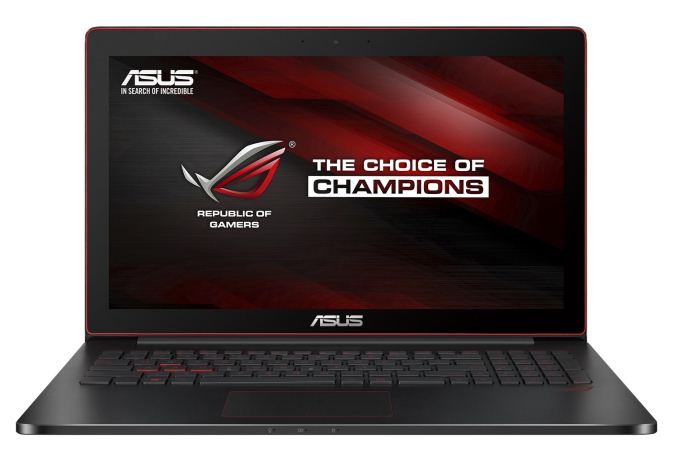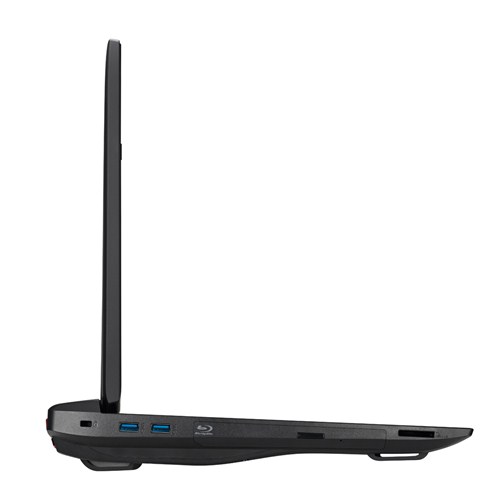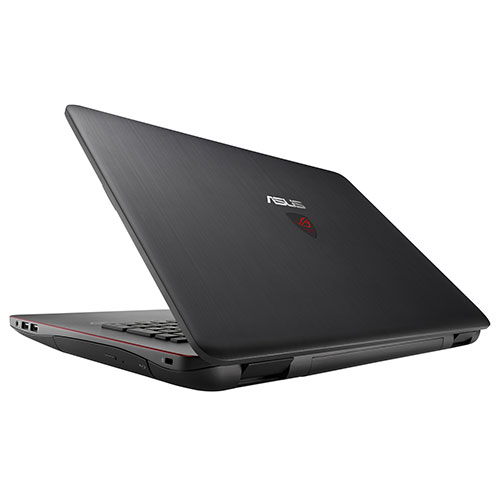ASUS Republic of Gamers Announces New Gaming Laptops
by Brett Howse on March 13, 2015 9:00 AM EST
Today ASUS is taking the wraps off of one new laptop and two refreshed models which fall under the Republic of Gamers stable. ASUS is adding a new 15.6 inch G501 laptop, which is one of the thinnest gaming laptops available. In addition, they are refreshing the G751 17.3 inch device, and the GL551 15.6 inch device. ASUS is targeting a wide audience with these selections, and each offers a different take and price point on the gaming laptop segment.
The G501 is the highest priced offering of the three, and packs a lot into its 0.81 inch (20.6 mm) 4.54 lb (2.06 kg) aluminum chassis. The processor du jour is the Haswell based Intel Core i7-4720HQ processor, which is a quad-core eight-thread mobile CPU with clock speeds of 2.6 GHz to 3.6 GHz and a 47 watt TDP. The G501 is well equipped for storage and memory, with 16 GB of DDR3, and a 512 GB PCIe x4 SSD. Yes, that’s correct. ASUS is one of the first to step up the SSD offering with a native PCIe device, and 512 GB should be plenty for your average gamer. ASUS has outfitted the G501 with the just launched NVIDIA GeForce GTX 960M GPU with 4 GB of GDDR5 memory. However the display should be a standout feature, with the G501 sporting a 15.6 inch 3840x2160 UHD IPS panel, for 282 pixels per inch. There is no touch option, and the panel has a matte coating. That is a lot of display for the GTX 960M to handle, so for gaming you will have to scale back somewhat depending on the game in question. ASUS has not forgotten about peripheral connectivity either with the G501 sporting 3 USB 3.0 ports, HDMI, a SD card reader, and a Thunderbolt port. The G501 also sports a massive 96 Wh battery, so assuming the GPU has Optimus enabled, battery life should be very reasonable for such a thin and relatively light gaming laptop. The G501 will start shipping in April for $1999 USD.
ASUS has outfitted the G501 with what they are calling Hyper Cool technology. As with many gaming laptops, there are dual fans, as well as copper heat pipes, but ASUS has tweaked the design so that the CPU and GPU are cooled independently. This will reduce the noise levels of the unit, but still allow maximum cooling for each unit as required. If we get one in for review, we can see how well they have done, so stay tuned for that.
| ASUS ROG Laptop Specifications | |||||
| G501JW-DS71 | G751JL-DS71 | GL551JW-DS71/ GL551JW-DS7 | |||
| CPU | Intel Core i7-4720HQ 4C/8T 2.6-3.6 GHz 47w | Intel Core i7-4720HQ 4C/8T 2.6-3.6 GHz 47w | Intel Core i7-4720HQ 4C/8T 2.6-3.6 GHz 47w | ||
| GPU | NVIDIA GeForce GTX 960M 4GB GDDR5 | NVIDIA GeForce GTX 965M 2GB GDDR5 | NVIDIA GeForce GTX 960M 2 GB GDDR5 | ||
| Display | 15.6" IPS 3840x2160 matte | 17.3" IPS 1920x1080 matte | 15.6" 1920x1080 matte (TN or IPS) | ||
| Memory | 16GB DDR3 | 16GB DDR3 | 16 GB DDR3 | ||
| Storage | 512GB PCIe x4 SSD | 1 TB 7200 RPM HDD | 1 TB 7200 RPM/128GB SSD + 1 TB 7200RPM | ||
| IO Ports | 1x Thunderbolt, 3 x USB 3.0, 1 x HDMI, 1 x SD Reader | 1 x Thunderbolt, 4 x USB 3.0, 1 x HDMI, 1 x VGA, 1 x SD Card Reader | 1 x mini-DP, 3 x USB 3.0, 1 x HDMI, 1 x SD Card Reader | ||
| Wireless | 802.11ac + BT 4.0 | 802.11ac + BT 4.0 | 802.11agn + BT 4.0 | ||
| Battery | 96 Wh | 88 Wh | unknown | ||
| Dimensions | 15.07 x 10.04 x 0.81-inch | 16.4 x 12.5 x 0.9-1.7-inch | 15 x 10 x 0.6-1.3-inch | ||
| Weight | 4.54lbs | 8.4lbs | 6lbs | ||
| MSRP | USD $1,999 | USD $1399 | USD $1099/$1299 | ||
ASUS G751
The G751 and GL551 are refreshed versions of existing models. As we have seen from several manufacturers, the GTX 960M announcement has spurred on a model refresh. The G751 (specifically the G751JL since ASUS has several G751 models up to an including the GTX 980M G751JY) is a 17.3 inch model, and ASUS has taken the opportunity to refresh this model with the same Intel Core i7-4720HQ processor as the G501. It will have the 2 GB GDDR5 version of the GTX 965M GPU powering the 1920x1080 matte display. 16 GB of DDR3 is standard, and a 1 TB 7200 RPM hard drive provides storage. It also includes 4 USB 3.0 ports, a HDMI port, a VGA port, a SD/MMC card reader, a DVDRW drive, and a Thunderbolt port. The 17.3 inch model will sport a 88 Wh battery in its 8.4 lb (3.81 kg) chassis, and will be priced at $1399.
ASUS G751
The GL551JW is basically the 15.6 inch equivalent to the G751, with the same CPU, but the GTX 960M GPU, powering the same resolution 1080p display, although it is not listed as IPS so it is possibly a TN version. 16 GB of memory is standard, and it can be had with either a 1 TB 7200 RPM drive, or a 128 GB mSATA plus 1 TB 7200 RPM drive. It also includes a DVDRW drive, 3 USB 3.0 ports, a HDMI port, a mini-DisplayPort, and a SD card reader, but unlike the previous two devices it also loses 802.11ac wireless and only supports 802.11n. The battery size is not mentioned, but the weight is 6 lbs (2.72 kg) which is substantially more than the G501. However to offset the extra weight of the laptop, you can keep some of the weight in your wallet, with the GL551 starting at $1099, and moving to $1299 for the SSD model.
ASUS GL551
It is great to see ASUS cater to both of the gamer markets with these models. Those who need mobility will certainly want to look at the G501, which is thin and light for a 15.6 inch gaming notebook. It is great to see them make the jump to PCIe based storage as well, and although the GPU is a bit underpowered to run it at native resolution when gaming, the UHD display should be excellent for the desktop, and a 96 Wh battery should make for reasonable time away from the power grid. For those that do not mind a bit more bulk, the G751 and GL551 both offer a good gaming experience for the money. Both have plenty of CPU power, and a GPU which should be fine with the native resolution of the displays.





















56 Comments
View All Comments
bloc - Saturday, March 14, 2015 - link
Hey Asus,Get rid of the number pad. What gamer is playing a game called excel?
If i'm paying $2000 for a laptop, I better be sitting dead center of the screen and not 15 degrees off to the left. The G and H should be located in the middle of the keyboard.
Know who finally realized this? The New Alienware 15". They got rid of the numpad.
Notmyusualid - Monday, March 16, 2015 - link
Yep, drop number pad for me too. Sitting off-center is not great...Wolfpup - Thursday, March 19, 2015 - link
I want the number pad. I use them a lot, and find it annoying when a keyboard doesn't have one.Of course most of the time I'm using an external (mechanical) keyboard + monitor anyway, but still.
Antronman - Monday, March 23, 2015 - link
And how am I supposed to play Gmod without a numpad?Tams80 - Sunday, March 15, 2015 - link
It's good to see a laptop with a decent battery capacity, and a decent GPU. I use my laptop for both travelling using the iGPU, and gaming when plugged into a wall socket. Having a large battery capacity also comes in helpful when you want to game, but don't have access to a wall socket (3 or so hours is better than 1).My Ativ Book 8 will do for now, but if AMD release something to compete with Nvidia; then I would be interested to see if ASUS offer an AMD version.
jabber - Sunday, March 15, 2015 - link
I think you'll be waiting a long time unfortunately. AMD are slowly getting dropped or frozen out of most markets.dragonsqrrl - Sunday, March 15, 2015 - link
AMD just doesn't have competitive mobile dGPU's due to the simple fact that their dGPU's in general aren't competitive in terms of performance per W, and I doubt this will change much with the upcoming 300 series.Notmyusualid - Monday, March 16, 2015 - link
I think it is because we've seen only one new architecture from AMD in their high end mobile for years (early 2012?), and I don't see a Windows system with it.As far as I can see, it goes something like this;
Desktop 7870 (Pitcairn?), lower clocks, becomes 7970M.
7970M, clock boost added for some temporary higher clocks, becomes 8970M.
M290X is just a rebrand of the HD 8970M with identical performance. (God I hate that rebranding)
The M295X was 'Tonga', but have you seen it anywhere, for sale? (outside of macs) I haven't. And the performance is below GTX680M as far as I can find.
Too busy with their consoles me thinks.
dragonsqrrl - Monday, March 16, 2015 - link
Actually the M295X is quite powerful. It's not quite as fast as a 970M, but it gets within 10% on average. But ya, it's iMac only at the moment, and honestly I don't see much of a market for it outside high-end AIO's. The problem is the TDP needed to achieve that performance. At ~125W I don't think AMD is even targeting notebooks with this. I'm not sure it's a practical option for even high-end desktop replacements, especially when the 970M has ~80W TDP and performs better.Really AMD's highest-end notebook dGPU is still the M290X (Pitcairn), and that's completely noncompetitive at this point. The 780M outperforms it...
Wolfpup - Thursday, March 19, 2015 - link
I think the reality is AMD can't get their act together with drivers, and inexplicably that's FIIIINALLY catching up to them. I swear, 10 years ago the situation was probably even worse, yet people would claim you were a fanboy for pointing it out.I'm mad that we still have to even talk about drivers. Optimus shouldn't exist. It works better than I'd expect, but still causes issues and just shouldn't be there. GPUS on CPUs are still a terrible idea-wasted die space. ALL PCs should get video driver updates from AMD or Nvidia directly...you shouldn't have to check before you buy a system whether it can. (Dell screwed up the Alpha mini-desktop by not letting Nvidia support it! On a GAMING system?!?)
I should not have to fight to find a system without Optimus and fight to find a system that runs normal drivers in 2015... Why do companies get all of this so very wrong? Why do companies selling systems explicitly marketed for GAMING often even manage to screw it up?